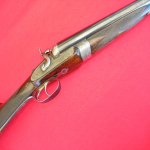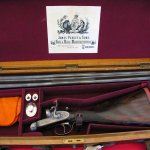Provincial quality
One of the most famous provincial makers was Thomas Horsley of York. His guns rivalled those from the best London and Birmingham makers, and while most provincial makers used Birmingham-made parts, it appears that Horsley only bought barrel tubes from the forgers, and his firm employed its own barrel borers, action makers, stockers and finishers. The guns were of high quality, made with quality materials, and finished to a very high degree. For over 25 years I have sought a Horsley pinfire, and the best I could manage, and only fairly recently, was to acquire an incomplete, converted specimen. The better the original quality, the more likely the conversion to centre-fire will be both successful and aesthetically pleasing, and Horsley guns are an example of guns that do not lose their looks in the conversion process. Finding a Horsley in its original pinfire configuration is a big order to fill, and I’m still searching.
Thomas Horsley was born on 17 July 1810, in Doncaster. Horsley reportedly worked for Richard Brunton, a local gunmaker, from about 1825 to 1830. In 1830 Horsley bought the Brunton business, and in 1834 moved his home and business to 48 Coney Street, York, while retaining part of the business in Doncaster. In 1851 Thomas was recorded living at the address with his wife, six daughters, his son Thomas, and an apprentice, Richard Dawson. At the time Thomas Horsley was employing four men. In 1856 the firm moved to 10 Coney Street, and in 1861 he was recorded as employing eight men and three boys (his son Thomas was an apprentice).
On 12 February 1862 Thomas obtained patent No. 374 for a sliding-bolt single-bite snap-action, with a push-forward lever acting on a sprung bolt. On 1 October 1863 he obtained another patent, No. 2410, for a pull-back top-lever or slide. The operating lever was located on the top strap instead of the trigger guard, operated in reverse on the same locking bolt. Patent No. 2410 is the one for which Thomas Horsley rightfully developed his fame. While superficially similar in operation to Westley Richards’s patent No. 2506 of 1862, already covered in this thread, the locking mechanism is quite different.
On 17 April 1867 Thomas Horsley obtained patent No. 1138 for levers which forcibly withdrew the strikers after firing, indicating he was an early proponent of the centre-fire system. On 2 March 1868 Horsley patented indicators to show whether a gun was loaded or not (patent No. 710), again for centre-fire guns, as with pinfire guns the pins indicate the state of loading. While he built snap-action pinfires starting in 1862, and his pull-lever actions from late 1863, he may have stopped building them by 1867, unless a client specifically wanted one. In any case, the time period in which Thomas Horsley built pinfire sporting guns was probably short, making my chances of finding an intact one that much harder.
By 1871 Thomas was employing 22 men and four boys, making him one of the largest provincial gun makers in the country. In about 1874 the firm became known as T Horsley & Son. Thomas Horsley died in 1882, but the family firm continued at various addresses until 1959, when it closed its doors for good.
Today’s gun, number 1450, was made in 1866. It is a bar-in-wood 12-bore sporting gun with the patent pull-top-lever, and it started out as a pinfire. At some point it was converted to centre-fire and fitted with an extractor for rimmed cartridges (something that is not necessary in a pinfire gun), and the pinfire hammers replaced with centre-fire hammers. The 29 15/16” damascus barrels have London proofs, and the top rib is signed “Thomas Horsley Maker York, Patent 2410”. The action bar has an unnumbered “Horsley’s Patent No.” cartouche, meaning the patent use number was not recorded on the gun. If a Horsley action was sold to another gun maker the patent use number would be added, essentially a licencing mark. Horsley might not have numbered the actions he used for his own guns, though some makers did. Without seeing more Horsley pinfires, I have no way of telling which practice he chose. If he only marked licenced actions, there is no way of knowing exactly how many pull-top-lever guns Horsley built in total.
The gun is a bar-in-wood construction with non-rebounding bar locks, signed “Thos Horsley Patent”. The pull-top-lever is signed "Patent” within a banner, and fine scroll engraving decorates the gun. The conversion is a serious affair, the pin holes have been filled and hidden, and it looks like the standing breech has been strengthened with a slab of steel and re-engraved, and fitted with centre-fire strikers. Look closely at the pictures, remarkable work. The thin fences of the pinfire needed reinforcing, something obviously desirable, but I’ve never seen this level of work in any other conversion. As the gun still has non-rebounding locks I’m guessing the conversion was done around 1870 or before, and from the standing breech work I would also guess the conversion could have been done by Horsley (the mismatched hammers with incorrect engraving might have been a later repair). Sadly this example has lost its fore-end, and the barrel fore-end loop. Complete, it would be a stunning, stunning gun – even as a conversion. The bores are pitted, and the gun weighs 6 lb 14 oz. (minus the fore-end).







10 Coney Street, York, where this gun was made, as it is today

One of the most famous provincial makers was Thomas Horsley of York. His guns rivalled those from the best London and Birmingham makers, and while most provincial makers used Birmingham-made parts, it appears that Horsley only bought barrel tubes from the forgers, and his firm employed its own barrel borers, action makers, stockers and finishers. The guns were of high quality, made with quality materials, and finished to a very high degree. For over 25 years I have sought a Horsley pinfire, and the best I could manage, and only fairly recently, was to acquire an incomplete, converted specimen. The better the original quality, the more likely the conversion to centre-fire will be both successful and aesthetically pleasing, and Horsley guns are an example of guns that do not lose their looks in the conversion process. Finding a Horsley in its original pinfire configuration is a big order to fill, and I’m still searching.
Thomas Horsley was born on 17 July 1810, in Doncaster. Horsley reportedly worked for Richard Brunton, a local gunmaker, from about 1825 to 1830. In 1830 Horsley bought the Brunton business, and in 1834 moved his home and business to 48 Coney Street, York, while retaining part of the business in Doncaster. In 1851 Thomas was recorded living at the address with his wife, six daughters, his son Thomas, and an apprentice, Richard Dawson. At the time Thomas Horsley was employing four men. In 1856 the firm moved to 10 Coney Street, and in 1861 he was recorded as employing eight men and three boys (his son Thomas was an apprentice).
On 12 February 1862 Thomas obtained patent No. 374 for a sliding-bolt single-bite snap-action, with a push-forward lever acting on a sprung bolt. On 1 October 1863 he obtained another patent, No. 2410, for a pull-back top-lever or slide. The operating lever was located on the top strap instead of the trigger guard, operated in reverse on the same locking bolt. Patent No. 2410 is the one for which Thomas Horsley rightfully developed his fame. While superficially similar in operation to Westley Richards’s patent No. 2506 of 1862, already covered in this thread, the locking mechanism is quite different.
On 17 April 1867 Thomas Horsley obtained patent No. 1138 for levers which forcibly withdrew the strikers after firing, indicating he was an early proponent of the centre-fire system. On 2 March 1868 Horsley patented indicators to show whether a gun was loaded or not (patent No. 710), again for centre-fire guns, as with pinfire guns the pins indicate the state of loading. While he built snap-action pinfires starting in 1862, and his pull-lever actions from late 1863, he may have stopped building them by 1867, unless a client specifically wanted one. In any case, the time period in which Thomas Horsley built pinfire sporting guns was probably short, making my chances of finding an intact one that much harder.
By 1871 Thomas was employing 22 men and four boys, making him one of the largest provincial gun makers in the country. In about 1874 the firm became known as T Horsley & Son. Thomas Horsley died in 1882, but the family firm continued at various addresses until 1959, when it closed its doors for good.
Today’s gun, number 1450, was made in 1866. It is a bar-in-wood 12-bore sporting gun with the patent pull-top-lever, and it started out as a pinfire. At some point it was converted to centre-fire and fitted with an extractor for rimmed cartridges (something that is not necessary in a pinfire gun), and the pinfire hammers replaced with centre-fire hammers. The 29 15/16” damascus barrels have London proofs, and the top rib is signed “Thomas Horsley Maker York, Patent 2410”. The action bar has an unnumbered “Horsley’s Patent No.” cartouche, meaning the patent use number was not recorded on the gun. If a Horsley action was sold to another gun maker the patent use number would be added, essentially a licencing mark. Horsley might not have numbered the actions he used for his own guns, though some makers did. Without seeing more Horsley pinfires, I have no way of telling which practice he chose. If he only marked licenced actions, there is no way of knowing exactly how many pull-top-lever guns Horsley built in total.
The gun is a bar-in-wood construction with non-rebounding bar locks, signed “Thos Horsley Patent”. The pull-top-lever is signed "Patent” within a banner, and fine scroll engraving decorates the gun. The conversion is a serious affair, the pin holes have been filled and hidden, and it looks like the standing breech has been strengthened with a slab of steel and re-engraved, and fitted with centre-fire strikers. Look closely at the pictures, remarkable work. The thin fences of the pinfire needed reinforcing, something obviously desirable, but I’ve never seen this level of work in any other conversion. As the gun still has non-rebounding locks I’m guessing the conversion was done around 1870 or before, and from the standing breech work I would also guess the conversion could have been done by Horsley (the mismatched hammers with incorrect engraving might have been a later repair). Sadly this example has lost its fore-end, and the barrel fore-end loop. Complete, it would be a stunning, stunning gun – even as a conversion. The bores are pitted, and the gun weighs 6 lb 14 oz. (minus the fore-end).







10 Coney Street, York, where this gun was made, as it is today

Last edited:


























































































































